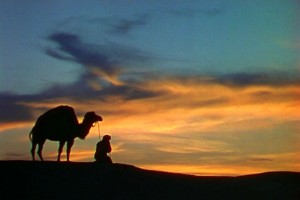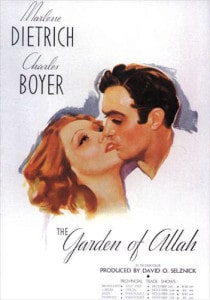 They loved each other with the fierceness of those who have been denied love!
They loved each other with the fierceness of those who have been denied love!
1936 was a very different time from today one would think, but perhaps after more consideration the similarities are a bit more than we would first admit. 1936 was perhaps the worst of the Great Depression, and FDR was still in his first term and not the near dictator he would become later during his great tenure as President. Today, as 2011 dawns, we are, so they claim, emerging from the Great Recession, and Barack Obama is in his first term and even his supporters must admit there is some doubt that he will be reelected for a second term. (After FDR’s service, the Constitution was amended to limit the maximum service of any sitting President to ten years.)
And so on the scene in 1936 comes David O. Selznick and his first foray into technicolor, The Garden of Allah, which is a purely escapist piece of hokum, to be blunt. But no more so than today’s numerous comic book films draw current audiences thoughts, if even momentarily, away from their current woes.
To make The Garden of Allah, which had been filmed previously in both 1916 and 1927, David O. Selznick assembled a stellar cast, featuring Marlene Dietrich (in her first color picture) and Charles Boyer as the two romantic leads, and Basil Rathbone and C. Aubrey Smith in lesser supporting roles. Unfortunately they are given extremely little to work with in terms of story and at times the dialogue is interminable. But again, there are also often painful closeups with lengthy silent periods as well.
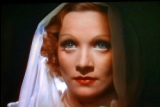 Marlene Dietrich plays Domini Enfilden (what a name!), a heiress looking for her spiritual path foward in life. Charles Boyer is Boris Androvsky, a Trappist monk in a monastery deep in the Sahara. As an aside, Charles Boyer is the only monk who knows the secret of making the monk’s secret wine, which they sell and is their primary source of revenue.
Marlene Dietrich plays Domini Enfilden (what a name!), a heiress looking for her spiritual path foward in life. Charles Boyer is Boris Androvsky, a Trappist monk in a monastery deep in the Sahara. As an aside, Charles Boyer is the only monk who knows the secret of making the monk’s secret wine, which they sell and is their primary source of revenue.
Domini is told for some reason to wander in the Sahara to find herself while Boris has a break with the abbots and quietly leaves the monastery. Long story short, they meet and fall madly for each other: but Boris never share his monastic past with Domini. They encounter a small band in the desert lead by Basil Rathbone who knows the truth and reveals Boris for what he is. Ultimately our lovers must part, as Boris returns to the abbots and Domini presumably wanders a bit more in the sand dunes.
As I mentioned, the dialogue at times is interminable and both leads have some challenges in pulling it off and never quite succeed in doing so. The plot doesn’t hold up today as our society has become perhaps far to cynical to allow Boris to simply return to the monastery and let the curtain fall. Plus nobody gets killed! Actually the plot didn’t work then either as the film was not a commercial success.
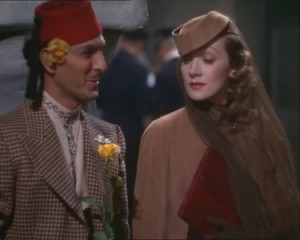 However, what the film lacks commercially it more than makes up for creatively and artistically. The cinematography is exquisite and we can see why the film was awarded a special Oscar for this. The picture truly is a feast for the eyes with numerous sweeping scenes of endless sand and caravans moving across the horizon. To me several of the longer shots seemed eerily predictive of later shots for Gone with the Wind, which, as we all know, was a David O. Selznick production.
However, what the film lacks commercially it more than makes up for creatively and artistically. The cinematography is exquisite and we can see why the film was awarded a special Oscar for this. The picture truly is a feast for the eyes with numerous sweeping scenes of endless sand and caravans moving across the horizon. To me several of the longer shots seemed eerily predictive of later shots for Gone with the Wind, which, as we all know, was a David O. Selznick production.
Granted Marlene Dietrich’s numerous costumes never suffer from the effects of the harsh climate and there is nary a hair out of place, even after one heck of a sandstorm. Much like a few westerns I’ve seen where the female lead rides in a wagon for weeks and climbs down looking like she’s ready for prom night.
As we watch this mess, we are wowed by the tremendous score by Max Steiner, which was nominated for an Oscar as well, although it lost to Korngold’s Anthony Adverse. As wonderful as the music is, it is sadly out of place, being far superior to the muddied plot and rather dyspeptic dribble which we are presented with. Visually and audibly (at least regarding the music on the latter), the picture is excellent. Otherwise….not so much.
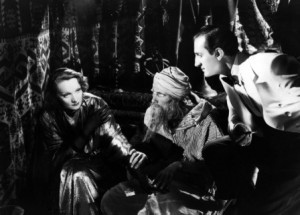 This was directed by little known Richard Boleslawski, a somewhat prominent Polish stage director who came to Hollywood in the 1930s and made a few pictures, passing away in 1937. It is hard, and perhaps impossible to state how much control he had in the proceedings. Knowing David O. Selznick’s methods, perhaps not too much.
This was directed by little known Richard Boleslawski, a somewhat prominent Polish stage director who came to Hollywood in the 1930s and made a few pictures, passing away in 1937. It is hard, and perhaps impossible to state how much control he had in the proceedings. Knowing David O. Selznick’s methods, perhaps not too much.
Given the age of the film it is amazing this was made in 1936, when color cinematography was still in its infancy and surely Selznick’s team was learning as they went. For this alone, this gorgeous photography, you should check this movie out. Ignore the plot as much as you can and some of the crazier lines of dialogue. Enjoy the music and the wonderful color photography. And wonder. Surely at least some fo the learnings from this picture come into full bloom a few years later at Tara.
